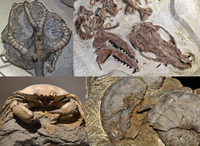Fossil record

Okay kiddo, so you know how when we go on a nature walk, we might find rocks with cool stuff inside like shells or bugs that used to live a long, long time ago? Well, scientists can also find these types of things in rocks that are really, really old - like millions of years old. That's called the fossil record.
You see, when ancient plants and animals die, their bodies might get covered in dirt or mud over time. Eventually, the dirt and mud harden into rock and the remains of the plant or animal turn into what we call a fossil.
Scientists use these fossils to learn all sorts of things about the creatures and plants that used to be around. By looking at the shape and size of the fossils, they can figure out what the animal looked like, what it ate, and how it moved. They can also learn about the different environments that existed a long time ago.
And if we're really lucky, sometimes fossils can tell us something really important about how life on Earth has changed over time. For example, scientists have found fossils that show how dinosaurs evolved and eventually went extinct, which has helped us understand how life on Earth has changed over millions of years.
So that's basically what the fossil record is - a bunch of old rocks with ancient plant and animal remains inside that scientists use to learn more about our planet's history. Cool, huh?
You see, when ancient plants and animals die, their bodies might get covered in dirt or mud over time. Eventually, the dirt and mud harden into rock and the remains of the plant or animal turn into what we call a fossil.
Scientists use these fossils to learn all sorts of things about the creatures and plants that used to be around. By looking at the shape and size of the fossils, they can figure out what the animal looked like, what it ate, and how it moved. They can also learn about the different environments that existed a long time ago.
And if we're really lucky, sometimes fossils can tell us something really important about how life on Earth has changed over time. For example, scientists have found fossils that show how dinosaurs evolved and eventually went extinct, which has helped us understand how life on Earth has changed over millions of years.
So that's basically what the fossil record is - a bunch of old rocks with ancient plant and animal remains inside that scientists use to learn more about our planet's history. Cool, huh?
Related topics others have asked about:
